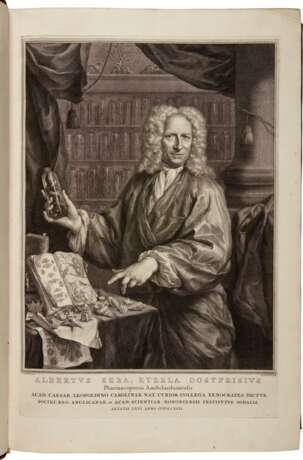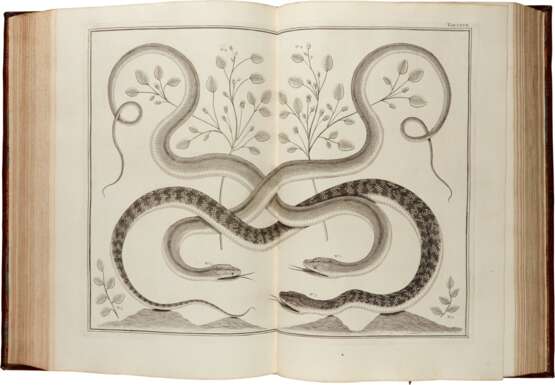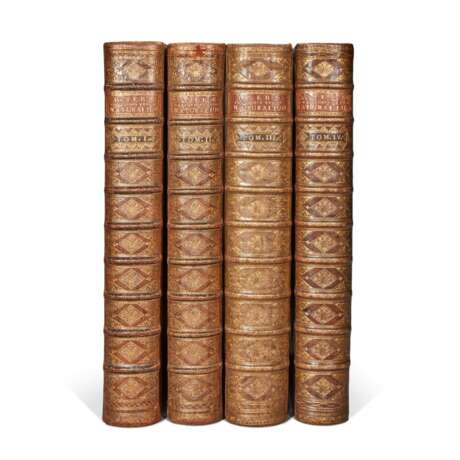Albertus Seba | Locupletissimi rerum naturalium thesauri accurata description, Amsterdam, 1734-1765, a fine copy in a contemporary binding
28.11.2023 14:00UTC +00:00
Classic
Продан
48260GBP £ 48 260
| Auctioneer | Sotheby´s |
|---|---|
| Место проведения | Великобритания, London |
Архив
Аукцион завершен. Ставки на лот больше не принимаются.

ID 1076599
Лот 76 | Albertus Seba | Locupletissimi rerum naturalium thesauri accurata description, Amsterdam, 1734-1765, a fine copy in a contemporary binding
Оценочная стоимость
£ 60 000 – 80 000
Locupletissimi rerum naturalium thesauri accurata descriptio, et iconibus artificiosissimis expressio, per universam physices historiam. Amsterdam: J. Wetsten, Gul. Smith, and Jansson-Waesberg [volumes 1 and 2]; Jansson-Waesberg [volume 3]; H. C. Arkesteum and H. Merkum, Peter Schouten [volume 4], 1734-1765
FIRST EDITION, 4 volumes, folio (510 x 335mm.), Dutch-Latin issue, half-titles, 4 title pages with engraved vignette by Tanjé after Dubourg, engraved frontispiece in volume I by P. Tanjé after Dubourg, engraved portrait of Seba by J. Houbraken after J. M. Quinkhard, 449 FINE ENGRAVED PLATES (175 OF THEM DOUBLE-PAGE) by Tanjé, A. van der Laan, F. de Bakker, A. van Buysen, de la Croix, J. Folkema, W. Jongman, F. Morellon, K. D. Pütter, J. Punt, and J. van der Speyk, very occasional minor browning
An extraordinary copy of an extraordinary record of an extraordinary collection—a Wunderkammer (“Cabinet of Wonders”) of natural history specimens from around the globe—featuring striking large folio engravings.
Albert Seba (1665-1736), was an Amsterdam apothecary who accumulated wealth and cultivated useful connections through his work for the Dutch East India Company, which at the time controlled the most extensive trade network in the world. Seba treated the illnesses and injuries of East India Company sailors and colonial administrators who landed in Amsterdam after voyages to far-flung Dutch colonies, and he solicited their aid in acquiring samples of foreign flora and fauna that might be of use to him in formulating medicines.
The first collection he built with their help sold in 1717 for the fabulous sum of 15,000 guilders to one of his clients, Tsar Peter the Great of Russia. An obsessive collector, he immediately began assembling a second, more spectacular cabinet. It included specimens of mammals, birds, plants, insects (including butterflies), reptiles, amphibians, fish, crustaceans, shells, minerals, and fossils from Asia, Africa, the Americas, and remote islands from Greenland to the South Pacific. His collection was so renowned that it attracted visitors as distinguished as Carl Linnaeus, the father of modern taxonomy, who found its contents useful in establishing his classification system of plant and animal life. (Linnaeus did, however, denounce the many-headed hydra pictured in this work as a fraud.)
Interest from scientists, artists, and dignitaries led to Seba’s decision to produce an illustrated catalogue of his collection. The engravings are memorable, both for the detail of the specimens depicted and for their artful, imaginative composition.
After Seba’s death in 1736, work continued on volumes III (fish and other marine life) and IV (insects, minerals, and fossils). To finance publication of the two final volumes, it was necessary to auction off Seba’s collection in 1752; many of the specimens found homes in European museums, where they remain today.
| Категория аукционного дома: | Гравюры, графика, книги |
|---|
| Категория аукционного дома: | Гравюры, графика, книги |
|---|
| Адрес торгов |
Sotheby´s 34-35 New Bond Street W1A 2AA London Великобритания | |
|---|---|---|
| Предосмотр |
| |
| Телефон | +44 (0) 20 7293 5000 | |
| Телефон | +1 212 606 7000 | |
| Условия использования | Условия использования |





